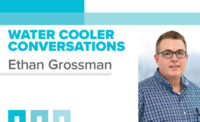There comes a time in life when we need to have uncomfortable conversations. Even when the topic is blatantly obvious, it can still be awkward and difficult to broach.
Take for example, the conveyance of sanitary waste. I was on a project once where the team was being challenged to earn as many “points” as possible so that the project could “earn” its rightful designation as a semi-precious metal. The small building was at a state university and designed on the slope of a hill. For me, the most logical solution was composting toilets. This was the perfect opportunity for facilities personnel to drive up to the small garage underneath the building and disperse fresh fertilizer around campus. “Don’t you ever suggest composting toilets on one of my projects, again!” That was the reaction I received from the project manager.
Discussing excrement can really hit a nerve with some people. Take, for example, one other time when some sanitary pipes failed at an underground parking garage in Maine. Imagine the rest of the team squirming and grimacing as us plumbing engineers began to discuss what temperature sanitary waste freezes. I even tried to discuss the concept of offensive odors with some HVAC engineers recently to which I was snubbed. Surely, there must be some measure of “bad smell” for which we design to.
Plumbing engineers will inevitably find themselves caught in awkward conversations and “stepping in it.” By no fault of ours, it may happen innocently enough as we are asked to provide a professional opinion on drain carry, bowl cleanliness or scouring velocity. Remember this: if your professional judgement ever offends, you can always take a sharp turn and save yourself by referring to third-party testing with miso paste (tofu). Many of us are familiar with the fact that miso paste has been used as a safe simulant.
My curiosity about sanitary waste and odor was heightened recently as I was walking the dog. Within milliseconds of Scout doing his business, a large fly showed up and came in for a landing. “Do insects have a sense of smell?” I wondered. It turns out that insects like bees and flies have an amazing sense of smell. I was reminded of a time when I took a horticulture class and the teacher showed us a plant from the African desert. The plant had flower that smelled like a decaying animal. The plant had adapted to its environment to attract flies for pollinating instead of bees.
I did some research and discovered that there is a science related to how the olfactory glands in our noses perceive the array of vapors we encounter throughout the day. Fittingly enough, the unit of smell is called the “olf.” The olf is defined as “the emission rate of air pollutants from a standard person” (ASHRAE Fundamentals). To me, the olf is one of those units tied to human behavior and involves engineering judgement to apply. Similar to the fixture unit, we can’t control how many times building occupants utilize fixtures, just as we can’t always control what leftovers somebody decides to heat up in the microwave. But, we can use the science that backs up these units to inform our design decisions.
The right formula
To use the olf, the ASHRAE guideline has a graph that would have us determine what percentage of people are dissatisfied. I call this the “turn on the fan” effect. If half the people in my household yell at me to “turn on the fan” after I use the bathroom, D equals 50%. The x-axis shows the ventilation rate. So, it would follow that if I leave my exhaust fan on all day the number of people who are dissatisfied goes down (See Chart on Page 31).
Credit is due to an indoor air quality (IAQ) specialist named Povl Ole Fanger for creating these measurements that are at our disposal. He developed the following expression to use in conjunction with the curve above (See formula below):

So, it would make sense that 100% of people are dissatisfied when the ventilation rate is very low. A “decipol” is defined as one olf ventilated at a rate of 20 cfm. Looking at the graph, this is right where it intersects Category A. The ASHRAE guide I was referencing doesn’t define the categories, but I presume it would be a group or environment where distractions from odor were most unacceptable; a classroom or workplace, for example. Following that logic, Category C might be a train station or concert venue. Testing the lower limits of these expressions for a “q” less than 0.332, if we have 10 people stuck in an elevator, there would need to be a minimum of 3.32 cfm to avoid everyone asking themselves, “What’s that smell?” Other metrics for the olf estimate that someone who just got on the elevator from the gym would emanate more olf — on the order of around 30.
The measure of odor and dissatisfaction makes me wonder if there is a place in our design of buildings for technology that could measure smell and regulate exhaust rates, saving energy by not running fans and equipment continuously.
I could envision myself in a meeting one day where a project manager is emphatically challenging the team to design something “net zero” or “rainbow platinum.” Like my experience with suggesting composting toilets, I might even recommend measuring olf and turning down the exhaust fans. I would know right away if saving energy was really that important, or we were all just pretending.
Pretending like there is no elephant in the room can end up causing more problems down the road. As the saying goes, we can ignore the elephant in the room at our own peril, but eventually the elephant will need to do what elephants do.
And that would be a big pile of miso.



